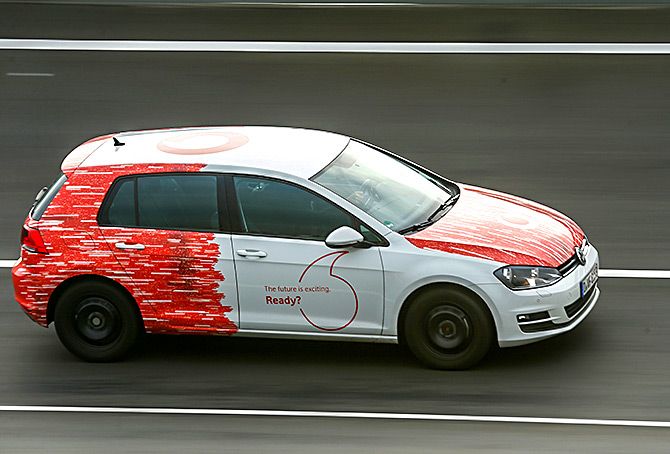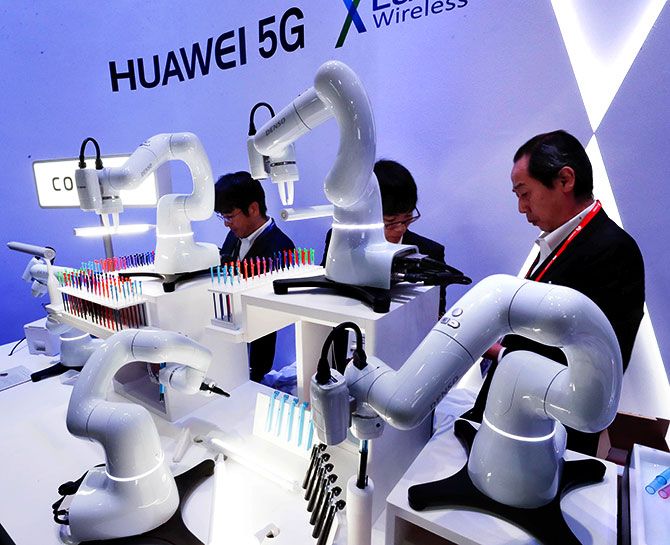In the not too distant future, you could see 5G technology being used for functions such as remotely-performed robotic surgeries, mine equipment operated remotely or cars driven by someone sitting hundreds of miles away.
While these ideas will certainly find application globally, the urgent need for them in India could spur swifter adoption here than elsewhere, says Alnoor Peermohamed.

The rollout of the fifth generation (5G) mobile technology in India may be two to three years away, but trials to harness its full potential are proceeding at a frenetic pace.
Indeed, unlike the launch of 4G or 3G before it, the country seems to be keen to jump onto the 5G bandwagon firing on all cylinders.
Regulators, networking device makers, telecom companies and industry partners say that apart from meeting the massive consumer demand for data, 5G will throw open a raft of new, game-changing, uses across sectors and industries.
Imagine, for example, a drone carrying critical medical supplies, such as a just-extracted human organ, navigating a densely populated area and landing on a precise, pre-set spot.
Recently, Ericsson and Bharti Airtel showcased this capability and demonstrated how 5G technology's network slicing feature could be used to offer guaranteed and uninterrupted quality of service (QoS) when it comes to unmanned aerial vehicles flying over areas inhabited by thousands of people.
(QoS is the ability of the network to achieve maximum bandwidth while taking care of other critical network performance elements such as latency, error rate and uptime.)

But it's not just drones delivering organs or medical supplies in emergency situations.
In the not too distant future, you could see 5G technology being used for functions such as remotely-performed robotic surgeries, mine equipment operated remotely or cars driven by someone sitting hundreds of miles away.
While these ideas will certainly find application globally, the urgent need for them in India could spur swifter adoption here than elsewhere.
"5G being a faster mobile broadband technology is probably not going to be the first use case in India, because 4G is good enough and we'll have fibre connectivity inside homes," says Sanjay Nayak, CEO and MD at Tejas Networks.
"Use cases I potentially see for 5G in India are mission critical applications, Industrial IoT and certain things that need lower latency."
Nayak adds that in the initial stages at least, 5G-powered mobile broadband will likely be used in remote rural areas.
The LMLC (low-mobility large-coverage) standard that India has prescribed for all new radio systems to be classified as 5G will not necessarily provide the fastest Internet access, but will mean that fewer transmitters are needed to cover larger areas.
With 5G, it could finally make financial sense for network operators to connect India's hinterland, paving the way for faster broadband through dedicated fibre lines.
"While we will hopefully see 5G deployments in India by 2020, it will take another 3-4 years for the mass proliferation of the technology," says a senior executive at one of India's leading telcos who did not wish to be named.
"There are a lot of challenges ahead, but applications harnessing the advantages of 5G, such as low latency or network slicing, will probably be the first out of the door."

Latency -- the tiny time lag that makes a web page load a few milliseconds after you click on it -- could be disastrous in certain critical applications.
But with 5G's low latency standards, operations such as remotely performed robotic surgeries can become possible, the telco executive explains.
"India could lead the pack in this field -- not because we're far ahead of other countries in robotic surgeries, but because there's an acute shortage of surgeons," he says. "We're in talks with players in these industries, and they're asking us to give it to them as soon as we possibly can," he adds.

Ericsson, along with telcos Reliance Jio and Airtel, has been exhibiting other applications riding on 5G.
Some of these were showcased at the India Mobile Congress in October this year.
Jio and Ericsson created a 5G-connected car that was remotely operated by the driver with a virtual reality headset.
A camera mounted on the vehicle relayed a video feed to the driver's headset, and he controlled the vehicle with the inputs he fed in.
A bus in Navi Mumbai was also driven remotely with the live video streaming being done on Ericsson's 28 GHz 5G network.
Both the use cases demonstrated the advantages of 5G technology's high bandwidth and low latency: The video the remote driver got to see was without lag and the inputs he gave also had an instantaneous effect.
Needless to say, any lag in the system could have resulted in a crash.

"5G is pegged to drive $27 billion in additional revenues for telecom providers by 2026," says Nitin Bansal, managing director and head of networks for India at Ericsson.
"While 5G will be used to enhance mobile broadband and fixed wireless access, it will also enable several other uses -- be it in drones, robotic surgeries, driverless tractors and Caterpillars in mining applications."
But where is the need for self-driving mine equipment when India has a surfeit of workers to do these jobs, you might ask.
Bansal explains that underground mines have to be evacuated ahead of blasting the rock, because there's a possibility of the mine shaft collapsing, apart from the fact that a lot of poisonous gases gets released during the process.
Clearing the mines of these gases can sometimes take days or even weeks.
However, 5G-driven remotely-operated machinery could go to work clearing rocks minutes after a detonation.
"That said, it may take some time for service providers to make these ideas financially viable," Bansal says.
The use cases being developed at Ericsson's test-bed at IIT Delhi and the 5G test-beds set up by the government at several other leading institutes will, he says, certainly help the process.

Tejas Network's Nayak says that to harness the full economic potential of 5G, India needs to build up capacity in developing fibre optic networking equipment which will be crucial in transmitting data at high speeds to the 5G base stations.
"From wireless transmitters to the chips that go into smartphones, the coming of 5G will create huge demand for hardware and this is where the real value is," says Nayak.
"As a country, we need to focus on building all the different pieces needed in the 5G ecosystem -- wireless, optical transmission, routers, chipsets and devices.
"We have 2-3 years before 5G adoption really kicks off and I think that's an adequate amount of time to do so."











